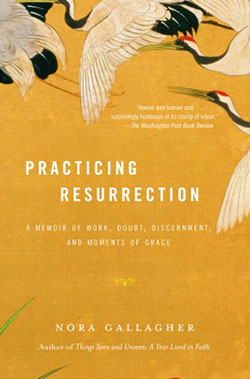Excerpt from Practicing Resurrection
A Memoir of Work, Doubt, Discernment, and Moments of Grace
At the end of John’s gospel, there is a small resurrection appearance, hardly worth a mention against the others, no locked doors, no vanishing acts. Peter and his crew are out fishing --it’s after Jesus has died and one imagines them sorrowful, empty. They’ve caught nothing. And then a man from shore yells out to them to cast their nets on the other side of the boat. Dubious--they’ve tried this-- they try it again and catch so many fish their nets begin to break. Peter recognizes his lord, jumps into the water and swims to him. And when he gets there, Jesus is cooking fish on the beach. I thought of Jesus the Sunday I served the bread. I thought of him as the man who calls out to us from the shore, the man who cooks breakfast after a long night of work. After his death he is a more humble man; he doesn’t heal, he has no dark fantasies of the end of the world, he does not proclaim himself either the son of man or as much of anything else. The gist of what he says is mild and low: love one another, forgive each other, feed each other.
Faith is only an approximation, as is memory, one never knows if one has the real thing in one’s grasp. It’s always only a reaching towards, but the day when I served the bread at Communion I thought that I knew something of the man Jesus by handing out his body, that he was much lower than I had thought before, much sweeter. He was like the movement of a crane’s wing, or a brother’s habit of saying, “baby sister,” or a woman suffering from clinical depression who is brave enough to want to live valorously. He was like all of these things, these movements, tied together, or he was the thing that tied them together. Maybe this was what was meant by communion, that he was still at it, helping us along, calling to us from shore. And we are meant to respond, to jump into the water, to swim toward him and toward each other.
On the day Harvey Milk and George Moscone were murdered by Dan White in San Francisco in 1978, I was a cub reporter for TIME, and I was sent out into the streets to gather “the people’s response.” I ended up at City Hall, having rushed across the Bay Bridge from a class I was lecturing to in Berkeley. Crowds gathered there, the site of the murders, in a park across the street from the broad front steps. Thousands of people had come there, by instinct, to stand quietly, just stand, or talk softy. I was standing next to a woman wearing a luxurious mink coat. She was not really, I said to myself, my kind of person. Too rich, wearing fur. Then Joan Baez stood up on the steps of city hall with a microphone and started to sing Amazing Grace. And we all started to sing with her. And I reached over without thinking and took the hand of the woman in the fur coat and she took my hand and we stood there, singing and holding hands with the tears running down our faces.
At the end of his essay on faith, the English composer Sydney Carter writes: “Do I have this experience or do I just imagine it? Is it nothing but possibility, like a song that is asking to be written? If that is all it is, that is good enough for me. That, after all, is one kind of reality, perhaps the only kind of religious reality. Song, God, a waving possibility: you must trust it, travel with it or it is not there.”
This is good enough, I thought that day in front of city hall, holding the woman’s hand in the crowd, and as I finished serving Communion; this is good enough for me.

Buy this book:
Amazon
Barnes & Noble
IndieBound
If you’d like to order books for resale, please contact Random House customer service for information on minimum order and competitive sales terms. Random House ships free freight.
Please call 1-800-733-3000 or email